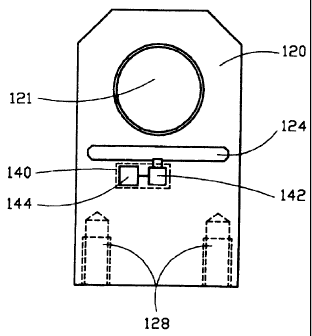Some of the information on this Web page has been provided by external sources. The Government of Canada is not responsible for the accuracy, reliability or currency of the information supplied by external sources. Users wishing to rely upon this information should consult directly with the source of the information. Content provided by external sources is not subject to official languages, privacy and accessibility requirements.
Any discrepancies in the text and image of the Claims and Abstract are due to differing posting times. Text of the Claims and Abstract are posted:
| (12) Patent: | (11) CA 2643965 |
|---|---|
| (54) English Title: | APPARATUS FOR GUIDING A STRIP |
| (54) French Title: | DISPOSITIF ET PROCEDE POUR GUIDER UNE BANDE |
| Status: | Deemed expired |
| (51) International Patent Classification (IPC): |
|
|---|---|
| (72) Inventors : |
|
| (73) Owners : |
|
| (71) Applicants : |
|
| (74) Agent: | RICHES, MCKENZIE & HERBERT LLP |
| (74) Associate agent: | |
| (45) Issued: | 2012-07-10 |
| (86) PCT Filing Date: | 2007-05-30 |
| (87) Open to Public Inspection: | 2007-12-13 |
| Examination requested: | 2010-04-14 |
| Availability of licence: | N/A |
| (25) Language of filing: | English |
| Patent Cooperation Treaty (PCT): | Yes |
|---|---|
| (86) PCT Filing Number: | PCT/EP2007/004753 |
| (87) International Publication Number: | WO2007/140903 |
| (85) National Entry: | 2008-08-27 |
| (30) Application Priority Data: | ||||||
|---|---|---|---|---|---|---|
|
The invention concerns a device for guiding a strip,
especially a metal strip, by means of one or more rolls. In
this regard, the roll force that acts on the rolls during the
guidance of the strip, i.e., under load, is measured.
Devices of this type are known in the prior art, e.g.,
from European Patent EP 0 539 784 22, which discloses a
continuous casting plant in which the rolls of a strand guide
apparatus are adjusted by means of hydraulic cylinders. To
measure the mechanical loads that act on the individual rolls
of the strand guide apparatus during its operation, a load
cell or force gauge is assigned to each roll. In this regard,
the load cell is mounted between the bearing block in which
the roll is supported and a segmented crosshead.
Moreover, the following documents disclose prior-art
devices of the aforementioned type:
-- DE 41 21 116 A1,
-- "Sensitive measurement of roll separation forces",
Steel Times International, DMG World Media, Lewes, GB, Vol.
L'invention concerne un dispositif et un procédé pour guider une bande, notamment une bande métallique. Les dispositifs connus de ce type présentent un dispositif de support (110), sur lequel sont fixés des coussinets (120). Dans les coussinets sont montés des rouleaux (130) pouvant tourner, afin de guider la bande. Afin de pouvoir mesurer de manière durable et fiable la force du rouleau agissant en charge, c'est-à-dire lors du guidage de la bande sur le rouleau, la déformation du coussinet, notamment en cas de charge, est détectée selon l'invention avec un dispositif de capteur puis on calcule à l'aide d'un dispositif d'analyse la force de rouleau recherchée à partir de la déformation du coussinet.
Note: Claims are shown in the official language in which they were submitted.
Note: Descriptions are shown in the official language in which they were submitted.

For a clearer understanding of the status of the application/patent presented on this page, the site Disclaimer , as well as the definitions for Patent , Administrative Status , Maintenance Fee and Payment History should be consulted.
| Title | Date |
|---|---|
| Forecasted Issue Date | 2012-07-10 |
| (86) PCT Filing Date | 2007-05-30 |
| (87) PCT Publication Date | 2007-12-13 |
| (85) National Entry | 2008-08-27 |
| Examination Requested | 2010-04-14 |
| (45) Issued | 2012-07-10 |
| Deemed Expired | 2017-05-30 |
There is no abandonment history.
| Fee Type | Anniversary Year | Due Date | Amount Paid | Paid Date |
|---|---|---|---|---|
| Application Fee | $400.00 | 2008-08-27 | ||
| Maintenance Fee - Application - New Act | 2 | 2009-06-01 | $100.00 | 2008-08-27 |
| Registration of a document - section 124 | $100.00 | 2008-11-10 | ||
| Registration of a document - section 124 | $100.00 | 2009-07-03 | ||
| Request for Examination | $800.00 | 2010-04-14 | ||
| Maintenance Fee - Application - New Act | 3 | 2010-05-31 | $100.00 | 2010-04-29 |
| Maintenance Fee - Application - New Act | 4 | 2011-05-30 | $100.00 | 2011-04-27 |
| Final Fee | $300.00 | 2012-03-23 | ||
| Maintenance Fee - Application - New Act | 5 | 2012-05-30 | $200.00 | 2012-04-23 |
| Maintenance Fee - Patent - New Act | 6 | 2013-05-30 | $200.00 | 2013-05-21 |
| Maintenance Fee - Patent - New Act | 7 | 2014-05-30 | $200.00 | 2014-05-19 |
| Maintenance Fee - Patent - New Act | 8 | 2015-06-01 | $200.00 | 2015-05-19 |
Note: Records showing the ownership history in alphabetical order.
| Current Owners on Record |
|---|
| SMS SIEMAG AKTIENGESELLSCHAFT |
| Past Owners on Record |
|---|
| GIRGENSOHN, ALBRECHT |
| RUNGE, ANDREAS |
| SMS DEMAG AG |